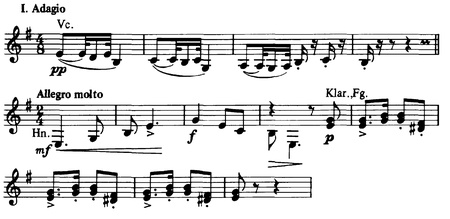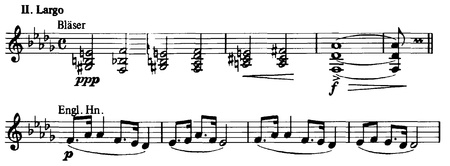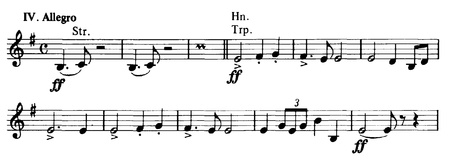Astronomy:Symphony No. 9 (Dvořák)
Template:Infobox musical composition
The Symphony No. 9 in E minor, "From the New World", Op. 95, B. 178 (Czech: Symfonie č. 9 e moll "Z nového světa"), popularly known as the New World Symphony, was composed by Antonín Dvořák in 1893 while he was the director of the National Conservatory of Music of America from 1892 to 1895. It premiered in New York City on 16 December 1893.[1] It is one of the most popular of all symphonies.[2] In older literature and recordings, this symphony was – as for its first publication – numbered as Symphony No. 5. Astronaut Neil Armstrong took a tape recording of the New World Symphony along during the Apollo 11 mission, the first Moon landing, in 1969.[3] The symphony was completed in the building that now houses the Bily Clocks Museum in Spillville, Iowa.[4]
Instrumentation
This symphony is scored for the following orchestra:
- 2 flutes (one doubling piccolo)[lower-alpha 1]
- 2 oboes (one doubling English horn)
- 2 clarinets in B♭ & A
- 2 bassoons
- 4 horns in E, C and F
- 2 trumpets in E, C and E♭
- 3 trombones: alto, tenor, bass
- Tuba (second movement only)[lower-alpha 2]
- Timpani
- Triangle (third movement only)
- Cymbals (fourth movement only)
- Strings
Form
A typical performance usually lasts around 40 minutes. The work is in four movements:
I. Adagio – Allegro molto
The movement is written in sonata form and begins with an introductory leitmotif in Adagio. This melodic outline also appears in the third movement of Dvořák's String Quintet No. 3 in E♭ major and his Humoresque No. 1. The exposition is based on three thematic subjects. The first in E minor is notable for its announcing and responsive phrases. The second is in G minor and undergoes a transformation such that it resembles a Czech polka. The exposition's closing theme in G major is known for being similar to the African-American spiritual "Swing Low, Sweet Chariot". The development primarily focuses on the main and closing themes, and the recapitulation consists of a repetition of the main theme as well as a transposition of the second and closing themes up a semitone. The movement is concluded with a coda, with the main theme stated by the brass above an orchestral tutti.[1]
In 1968, Serge Gainsbourg sampled the main theme of the movement for his song Initials B.B.[citation needed]
II. Largo
The second movement is introduced by a harmonic progression of chords in the wind instruments. Beckerman interprets these chords as a musical rendition of the narrative formula "Once upon a time".[1] Then a solo cor anglais (English horn) plays the famous main theme in D-flat major accompanied by muted strings. Dvořák was said to have changed the theme from clarinet to cor anglais as it reminded him of the voice of Harry Burleigh. The movement's middle section contains a passage in C♯ minor evoking a nostalgic and desolate mood which eventually leads into a funeral march above pizzicato steps in the basses. It is followed by a quasi-scherzo that incorporates this movement's theme as well as the first movement's main and closing themes. The Largo is concluded with the soft return of the main theme and introductory chords.
III. Molto vivace
The movement is a scherzo written in ternary form, with influences from Henry Wadsworth Longfellow's The Song of Hiawatha. The stirring rhythm of the first part is interrupted by a trio middle section. The first part is then repeated, followed by an echo in the coda of the first movement's main theme.[1]
IV. Allegro con fuoco
The final movement is also written in sonata form. After a brief introduction, the horns and trumpets declare the movement's main theme against sharp chords played by the rest of the orchestra. The second theme is then presented by the clarinet above tremolos in the strings. The development not only works with these two themes but also recalls the main themes of the first and second movements and a fragment of the Scherzo. Following the recapitulation which begins in the unexpected key of G minor but later corrects itself back to the original key, the movement reaches its climax in the coda, in which materials from the first three movements are reviewed for a final time while the Picardy third is expanded after the orchestra triumphantly plays a "modally altered" plagal cadence.[5] The main theme, especially its occurrence in bar 321, bears a close resemblance to the opening theme of the Hans Heiling Overture by Heinrich Marschner.
Influences
Dvořák was interested in Native American music and the African-American spirituals he heard in North America. While director of the National Conservatory he encountered an African-American student, Harry T. Burleigh, who sang traditional spirituals to him. Burleigh, later a composer himself, said that Dvořák had absorbed their "spirit" before writing his own melodies.[6] Dvořák stated:
I am convinced that the future music of this country must be founded on what are called Negro melodies. These can be the foundation of a serious and original school of composition, to be developed in the United States. These beautiful and varied themes are the product of the soil. They are the folk songs of America and your composers must turn to them.[7]
The symphony was commissioned by the New York Philharmonic, and premiered on 16 December 1893, at Carnegie Hall conducted by Anton Seidl. A day earlier, in an article published in the New York Herald on 15 December 1893, Dvořák further explained how Native American music influenced his symphony:
I have not actually used any of the [Native American] melodies. I have simply written original themes embodying the peculiarities of the Indian music, and, using these themes as subjects, have developed them with all the resources of modern rhythms, counterpoint, and orchestral colour.[8]
In the same article, Dvořák stated that he regarded the symphony's second movement as a "sketch or study for a later work, either a cantata or opera ... which will be based upon Longfellow's Hiawatha"[9] (Dvořák never actually wrote such a piece).[9] He also wrote that the third movement scherzo was "suggested by the scene at the feast in Hiawatha where the Indians dance".[9]
In 1893, a newspaper interview quoted Dvořák as saying "I found that the music of the negroes and of the Indians was practically identical", and that "the music of the two races bore a remarkable similarity to the music of Scotland".[10][11] Most historians agree that Dvořák is referring to the pentatonic scale, which is typical of each of these musical traditions.[12]
In a 2008 article in The Chronicle of Higher Education, prominent musicologist Joseph Horowitz states that African-American spirituals were a major influence on Dvořák's music written in North America, quoting him from an 1893 interview in the New York Herald as saying, "In the negro melodies of America I discover all that is needed for a great and noble school of music."[13] Dvořák did, it seems, borrow rhythms from the music of his native Bohemia, as notably in his Slavonic Dances, and the pentatonic scale in some of his music written in North America from African-American and/or Native American sources. Statements that he borrowed melodies are often made but seldom supported by specifics. One verified example is the song of the Scarlet Tanager in the Quartet. Michael Steinberg writes[14] that a flute solo theme in the first movement of the symphony resembles the spiritual "Swing Low, Sweet Chariot".[15] Leonard Bernstein averred that the symphony was truly multinational in its foundations.[16]
Dvořák was influenced not only by music he had heard but also by what he had seen in America. He wrote that he would not have composed his American pieces as he had if he had not seen America.[17] It has been said that Dvořák was inspired by the "wide open spaces" of America, such as prairies he may have seen on his trip to Iowa in the summer of 1893.[18] Notices about several performances of the symphony include the phrase "wide open spaces" about what inspired the symphony and/or about the feelings it conveys to listeners.[lower-alpha 3]
Dvořák was also influenced by the style and techniques used by earlier classical composers including Beethoven and Schubert.[19] The falling fourths and timpani strokes in the New World Symphony's Scherzo movement evoke the Scherzo of Beethoven's Choral Symphony (Symphony No. 9). The use of flashbacks to prior movements in the New World Symphony's last movement is reminiscent of Beethoven quoting prior movements in the opening Presto of the Choral Symphony's final movement.[1]
Reception
At the premiere in Carnegie Hall, the end of every movement was met with thunderous clapping and Dvořák felt obliged to stand up and bow.[2] This was one of the greatest public triumphs of Dvořák's career. When the symphony was published, several European orchestras soon performed it. Alexander Mackenzie conducted the London Philharmonic Society in the first London performance on 21 June 1894.[2] Clapham says the symphony became "one of the most popular of all time" and at a time when the composer's main works were being welcomed in no more than ten countries, this symphony reached the rest of the musical world and has become a "universal favorite".[2] As of 1978, it had been performed more often "than any other symphony at the Royal Festival Hall, London" and is in "tremendous demand in Japan".[2]
"Goin' Home"
The theme from the Largo was adapted into the spiritual-like song "Goin' Home" (often mistakenly considered a folk song or traditional spiritual) by Dvořák's pupil William Arms Fisher, who wrote the lyrics in 1922.[20][21][22][23]
In the UK, the theme became familiar to the general public after its use in a 1973 television advert directed by Ridley Scott for the Hovis bakery.[24]
See also
- Choral Fantasy (Beethoven)
- Ode to Joy
- Piano Concerto No. 1 (Tchaikovsky)
- Symphony No. 8 (Schubert)
- Symphony No. 9 (Beethoven)
Explanatory notes
- ↑ The scoring of piccolo in this symphony is unusual; although the English horn is brought in for the solo in the second movement, the piccolo plays only a short phrase in the first, and nothing else.
- ↑ Tuba is only scored in the second movement. According to the full score book published by Dover, Trombone basso e Tuba is indicated in some measures in the second movement; the bass trombone is used with the two other trombones in movements 1, 2 and 4.
- ↑ For example, the Chicago Symphony, 19 June 2009.
References
- ↑ 1.0 1.1 1.2 1.3 1.4 "Symphony No. 9 "From the New World"". http://www.antonin-dvorak.cz/en/symphony9.
- ↑ 2.0 2.1 2.2 2.3 2.4 Clapham, John, Dvořák, Norton, New York, 1979, pp. 132–133.
- ↑ Wagener, Leon (2005). One Giant Leap: Neil Armstrong's Stellar American Journey. Tom Doherty Associates. p. 176. ISBN 9781466828568. https://books.google.com/books?id=DqN0OqpXKCwC&q=Dvo%C5%99%C3%A1k+9+apollo+11&pg=PA176.
- ↑ Pohlen, Jerome (1 April 2005). Oddball Iowa: A Guide to Some Really Strange Places. Chicago Review Press. p. 100. ISBN 9781569764688. https://books.google.com/books?id=BgUcucp3NvUC&q=%22bily+clock+museum%22&pg=PA100.
- ↑ Cross, Milton; Ewen, David (1962). "Antonín Dvořák". Milton Cross' Encyclopedia of the Great Composers and Their Music. 1. Garden City, New York: Doubleday and Company, Inc.. p. 239.
- ↑ Jean E. Snyder, "A great and noble school of music: Dvořák, Harry T. Burleigh, and the African American Spiritual", in Tibbets, John C., editor, Dvorak in America: 1892–1895, Amadeus Press, Portland, Oregon, 1993, p. 131.
- ↑ Gutmann, Peter. "Dvorak's "New World" Symphony". Classical Notes. http://www.classicalnotes.net/columns/newworld.html.
- ↑ Neas, Patrick (March 4, 2017). "The Classical Beat: ... Dvorak at Helzberg Hall". Kansas City Star. https://www.kansascity.com/entertainment/music-news-reviews/classical-music-dance/article135859568.html.
- ↑ 9.0 9.1 9.2 Beckerman, Michael. "About the Hiawatha Melodrama". josephhorowitz.com. http://josephhorowitz.com/up_files/File/hiawatha%20melodrama%20note.pdf.
- ↑ Kerkering, John D.; Gelpi, Albert; Posnock, Ross (2003). The Poetics of National and Racial Identity in Nineteenth-Century American Literature. Cambridge University Press. ISBN 0-521-83114-8. https://archive.org/details/poeticsofnationa0000kerk.
- ↑ Beckerman, Michael Brim (2003). New Worlds of Dvorak: Searching in America for the Composer's Inner Life. W. W. Norton & Company. ISBN 0-393-04706-7.
- ↑ Clapham, John (1958). "The Evolution of Dvorak's Symphony "From the New World"". The Musical Quarterly (Oxford University Press) (2): 167–183. doi:10.1093/mq/XLIV.2.167.
- ↑ Horowitz, Joseph (11 January 2008). "New World Symphony and Discord". The Chronicle of Higher Education. http://chronicle.com/article/New-World-SymphonyDiscord/17761/.(Subscription content?)
- ↑ Michael Steinberg, The Symphony: A Listener's Guide, Oxford University Press, 1995, p. 152
- ↑ "Swing Low, Sweet Chariot" was written by Wallis Willis, a Native American of the Choctaw Nation and former slave, and popularized by the African-American Fisk Jubilee Singers
- ↑ Leonard Bernstein: 1953 American Decca recordings. DGG 477 0002. Comments on the 2nd compact disc.
- ↑ Letter to Emil Kozanek, 15 September 1893, translated in Letters of Composers, edited by Gertrude Norman and Miriam Lubell Shrifte (1946, Alfred A. Knopf, New York).
- ↑ Sullivan, Jack (1999), New World Symphonies: How American Culture Changed European Music, Yale University Press, p. ix
- ↑ "Antonín Dvorák (1841–1904)". http://spotlightonmusic.macmillanmh.com/n/teachers/articles/composers-and-lyricists/anton-in-dvor-ak.
- ↑ Otakar Šourek, Antonín Dvořák: his life and works, Philosophical library, 1954, p. 59; Glenn Watkins, Proof through the night: music and the Great War, Volume 1, University of California Press, 2003, p. 273.
- ↑ Keller, James M. (c. 2013). "Program Notes: Dvořák: Symphony No. 9 in E minor, Opus 95, From the New World". San Francisco Symphony. http://www.sfsymphony.org/Watch-Listen-Learn/Read-Program-Notes/Program-Notes/DVORAK-Symphony-No-9-in-E-minor,-Opus-95,-From-the.aspx.
- ↑ Franya J. Berkman, Monument Eternal: The Music of Alice Coltrane, Wesleyan University Press, 2010, p. 88.
- ↑ Smith, Jane Stuart; Carlson, Betty (1995). The Gift of Music: Great Composers and Their Influence. Crossway Books. p. 157. ISBN 978-0-89107-869-2. https://books.google.com/books?id=kZPyvhV_caAC&pg=RA1-PA157. Retrieved 9 September 2012. "The largo of the second movement has a hauntingly beautiful melody played by the English horn. There is a sense of longing about it, and a spiritual has been adapted from it, 'Going Home'"
- ↑ "Hovis 'Boy on the Bike' advert returns to TV with new music – here's a first look". https://www.classicfm.com/discover-music/hovis-boy-on-the-bike-tv-advert-dvorak/.
Further reading
- Beckerman, Michael, ed (1993). "The Master's Little Joke". Dvořák and his World. Princeton, New Jersey: Princeton University Press. pp. 134–436. ISBN 0-691-03386-2. https://books.google.com/books?id=-udEAcFiGWoC&pg=PA134-156.
- Brown, A. Peter (2003). The symphonic repertoire. 4. Bloomington: Indiana University Press. pp. 410–436. ISBN 0-253-33488-8. https://books.google.com/books?id=vRI_PGC_IBEC&pg=PA411.
- Philip Henry Goepp (1913). Symphonies and their meaning: Third series: Modern symphonies. Philadelphia: J. B. Lippincott Company. pp. 195–207. https://books.google.com/books?id=dOMvAAAAMAAJ&pg=PA195.
- Kurt Honolka (2004). Dvořák. London: Haus Publishing. ISBN 1-904341-52-7. https://books.google.com/books?id=kAVSQlZr-i4C.
External links
- Score from Indiana University
- Score from Mutopia Project
- True Story of "Goin' Home" – From Bohemia to Boston
- Performance of "Goin' Home" by the New York Festival of Song from the Isabella Stewart Gardner Museum in MP3 format
- "New World Symphony : Complete listing of the recordings" (in fr). MusicaBohemica. http://musicabohemica.blogspot.fr/2014/01/new-world-symphony-recordings.html.
- Original manuscript parts at the New York Philharmonic Archives
 |







